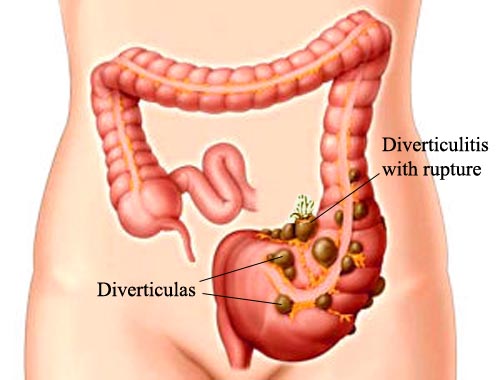Diverticulosis (Diverticulitis, Diverticular disease)
Diverticulitis is small, bulging sacs or pouches of the inner lining of the intestine (diverticulosis) that become inflamed or infected. Most often, these pouches are in the large intestine (colon). No one knows exactly what causes the sacs, or pouches of diverticulosis to form. Eating a low-fiber diet is one of the most likely causes. People who eat mostly processed food, as many Americans eat, do not get enough fiber in their diet. Processed foods include white rice, white bread, most breakfast cereals, crackers, and pretzels. As a result, constipation and hard stools are more likely to occur, causing people to strain when passing stools. This increases the pressure in the colon or intestines and may cause these pouches to form. When pockets develop in the wall of the colon, this is called diverticulosis. The pockets that form are called diverticula; the pockets pick up fecal matter as the body's waste is propelled through the colon. Diverticulosis and diverticulitis are classified as diverticular disease. The main difference between diverticulosis and diverticulitis is that there is no inflammation, and with the second there is. Approximately 80 percent of the individuals who have been diagnosed with diverticulosis never advance to the more serious condition, diverticulitis. Most people who have diverticulosis have no symptoms at all. Diverticulosis is very common. It is found in more than half of Americans over age 60. Diverticulitis is caused by small pieces of stool (feces) that become trapped in these pouches, causing infection or inflammation. The disorder is usually asymptomatic; may have constipation or nonspecific abdominal symptoms. Symptomatic acute diverticulitis presents with fever, leukocytosis, and left lower quadrant pain. Contrast enema and colonoscopy are common diagnostic tests; CT scan when diagnosis unclear. Treatment includes bowel rest, antibiotics, and surgical intervention. Complications include bleeding, segmental colitis, perforation, abscess, fistulas, and obstruction. Acute bleeding managed by IV fluids or blood transfusion, and radiologically directed hemostasis (embolization).
